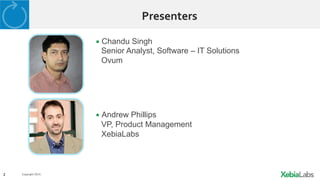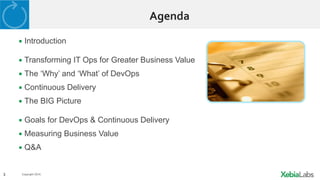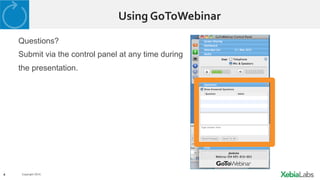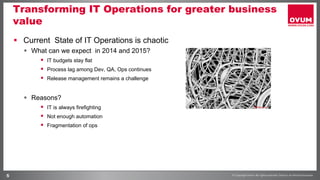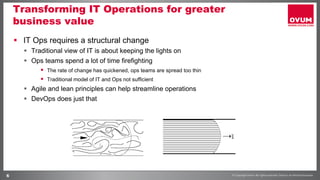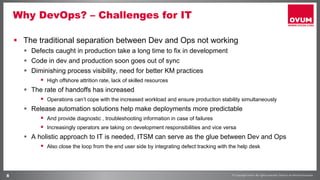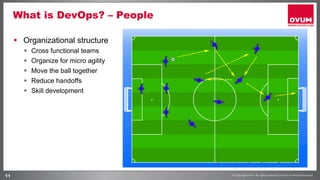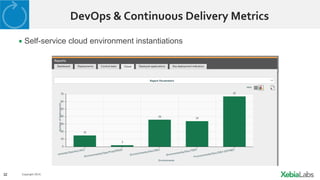Webinar: Demonstrating Business Value for DevOps & Continuous Delivery
- 1. Demonstrating Business Value for DevOps & Continuous Delivery Chandu Singh, OVUM Andrew Phillips, XebiaLabs | 23 April 2014
- 2. 2 Copyright 2014. Presenters ▪ Chandu Singh Senior Analyst, Software – IT Solutions Ovum ▪ Andrew Phillips VP, Product Management XebiaLabs
- 3. 3 Copyright 2014. Agenda ▪ Introduction ▪ Transforming IT Ops for Greater Business Value ▪ The ‘Why’ and ‘What’ of DevOps ▪ Continuous Delivery ▪ The BIG Picture ▪ Goals for DevOps & Continuous Delivery ▪ Measuring Business Value ▪ Q&A
- 4. 4 Copyright 2014. Using GoToWebinar Questions? Submit via the control panel at any time during the presentation.
- 5. 5 Transforming IT Operations for greater business value § Current State of IT Operations is chaotic § What can we expect in 2014 and 2015? § IT budgets stay flat § Process lag among Dev, QA, Ops continues § Release management remains a challenge § Reasons? § IT is always firefighting § Not enough automation § Fragmentation of ops
- 6. 6 Transforming IT Operations for greater business value § IT Ops requires a structural change § Traditional view of IT is about keeping the lights on § Ops teams spend a lot of time firefighting § The rate of change has quickened, ops teams are spread too thin § Traditional model of IT and Ops not sufficient § Agile and lean principles can help streamline operations § DevOps does just that
- 7. 7 Why DevOps? – Challenges for the Business § The changing business context § Exposure to multiple target platforms – Self hosted, Mobile, Public Cloud § Accelerated pace of development to cope with growing volumes § Businesses need a handle on development processes § IT needs to deliver value sooner, with constant or shrinking budgets § Need to ensure optimal performance and security of production apps § Business needs higher throughput from IT § DevOps brings Agile practices and thinking to operations § Helps remove slack from the value delivery chain
- 8. 8 Why DevOps? – Challenges for IT § The traditional separation between Dev and Ops not working § Defects caught in production take a long time to fix in development § Code in dev and production soon goes out of sync § Diminishing process visibility, need for better KM practices § High offshore attrition rate, lack of skilled resources § The rate of handoffs has increased § Operations can’t cope with the increased workload and ensure production stability simultaneously § Release automation solutions help make deployments more predictable § And provide diagnostic , troubleshooting information in case of failures § Increasingly operators are taking on development responsibilities and vice versa § A holistic approach to IT is needed, ITSM can serve as the glue between Dev and Ops § Also close the loop from the end user side by integrating defect tracking with the help desk
- 9. 9 What is DevOps? § DevOps is Agile Operations § DevOps goals § Better resource provisioning for production § Better collaboration between different teams § Better release management § Less production defects § More automation § Shorter release cycles § Continuous Delivery § Streamlined process from development to deployment – A pipeline! § Improved production performance management
- 10. 10 What is DevOps? § Dev is agile, operations needs to be agile too! § Integrated dev and ops § Invest in § People § Processes § Tools § Plan for Continuous Delivery § Reduce test backlog § Implement test automation earlier in the lifecycle § Templates & best practice guides § Increase accountability, reduce handoffs
- 11. 11 What is DevOps? – People § Organizational structure § Cross functional teams § Organize for micro agility § Move the ball together § Reduce handoffs § Skill development
- 12. 12 What is DevOps? – Process § Start early, plan ahead! § DevOps considerations should be incorporated at the requirements stage itself § A major chunk of the non functional requirements are indeed operational aspects of the system § Production monitoring § Transaction logging, metrics collection § Security § Target platform configuration management § Availability
- 13. 13 What is DevOps? – Process § After the requirements and design stage, DevOps is about automation and collaboration § Automate development activities such as § Builds § Tests § Deployment § Devs - Collaborate with Ops § Look at the application end to end § Post release § Monitor § Measure § Improve through iteration § Don’t forget – ITSM the glue! We need to close the loop from the end user side.
- 14. 14 What is DevOps? – Tools § What can be automated? § Builds – Build Management, Build Automation § Tests – Test Management, Test Automation § Deployments – Environment Provisioning and Deployment Automation § Release Coordination and Management § System Configuration and Roll-Out § Metrics Collection and Monitoring § Collate Metrics for capacity planning § Trend and Issue analysis § Share metrics among teams for better collaboration § Feedback helps improve performance § Performance Management § Organizations already have some pieces of the puzzle!
- 15. 15 What is DevOps? – Tools (Cloud) § Why DevOps in the cloud? § Clouds can be accessed through APIs and are therefore programmable § Infrastructure elements turn into programmable components and can be automated § Location transparency allows scaling or node failures to be handled more effectively § DevOps in the cloud is about automation and repeatable processes § Automation helps you scale effectively § Resources can be provisioned on demand § With DevOps + Cloud your resource requirements go down § Helps create self-healing systems § Dynamic Dev, QA, and Production Environments § Continuous Integration and Continuous Deployment
- 16. 16 Continuous Delivery § To automate the deployment of changes, new versions of software to production environments if they pass all quality checks. § DevOps is an idea, continuous delivery is an implementable process. § It’s a moving target for most organizations § Aim for continuous delivery and whatever you hit will be an improvement over the status quo § Design apps for continuous delivery – manage system state in config files § Do UAT in production!
- 17. 17 The BIG picture – DevOps Adoption § DevOps will not work with the ‘hole in the floor’ approach § Stakeholder buy-in is essential to DevOps success § It is easy to get bogged down with definitions and buzzwords § Understand what DevOps means in the context of your organization § Understand why it’s required, and the problem that you are trying to solve § Identify where the process bottlenecks are
- 18. 18 The BIG picture – The takeaway § To improve, you need feedback on what went wrong § To improve faster, you need faster feedback § Managing enterprise IT in the present context is about constantly improving/shortening the feedback loops § Agile is for business agility § Enabling IT to deliver sooner, and exploit opportunities within their value-frame. § Enable IT to correct course in-flight with shorter feedback loops § Shorter feedback loops are possible by dividing the work in manageable chunks § Atomic accountability
- 19. 19 Some Numbers on Release Mgmt. § Faulty releases account for 70% of all production failures; 30% is faulty code. § DevOps and CD help achieve faster time to market by avoiding big bang releases, and with the help of automation. Around 20% time saved. For greater benefits orgs need service virtualization during testing. § Avoid faulty releases by 70% (see above), more importantly minimize the business impact of a faulty release with automated rollback. Restore service 10-15x faster. § Release frequently in short increments 80-100% safer releases. NO more code freeze!
- 20. 20 Case Study – a large global financial services company § Company A was used to half yearly, big bang releases. Roughly 37-40% of all releases failed on first deployment. Invariably the error would be due to a manual error, such as missing config file entry, wrong path, wrong IP when moving to production from staging and so on, at times the defect would take a few hours time to locate and fix. In a few cases it would be a code error and it would take longer. § The devs and operations team were scared of releasing code, they ran through lengthy checklists, code reviews, the whole team spent 2-3 days preparing for the release. For a 15 member team it meant wasting around 300 person-hours per release. § With DevOps & CD (automation) the release prep time has come down to 20 minutes per release. They release more frequently, averaging 3 releases a month, an 18x increase. Faults due to manual error have been eliminated.
- 22. 22 Copyright 2014. Goals for DevOps & Continuous Delivery ▪ DevOps & Continuous Delivery are powerful principles, but they are not organizational goals ▪ We’ve just heard about some measurable goals companies have successfully defined for their DevOps & CD initiatives ▪ Ultimately, there’s only one metric that matters for most enterprises:
- 23. 23 Copyright 2014. Goals for DevOps & Continuous Delivery ▪ DevOps & Continuous Delivery are powerful principles, but they are not organizational goals ▪ We’ve just heard about some measurable goals companies have successfully defined for their DevOps & CD initiatives ▪ Ultimately, there’s only one metric that matters for most enterprises: The Bottom Line
- 24. 24 Copyright 2014. Goals for DevOps & Continuous Delivery ▪ DevOps & Continuous Delivery are powerful principles, but they are not organizational goals ▪ We’ve just heard about some measurable goals companies have successfully defined for their DevOps & CD initiatives ▪ Ultimately, there’s only one metric that matters for most enterprises: The Bottom Line − But it’s surprisingly hard to gain useful information about the impact of a new feature on the bottom line if changes are always Big Bangs − One important goal of DevOps & Continuous Delivery is thus to enable smaller changes to be made more regularly to allow for better analysis of the effectiveness of changes − Of course, we need to have the ability to monitor business value generated by our systems in order to make this possible!
- 25. 25 Copyright 2014. Goals for DevOps & Continuous Delivery ▪ So “frequency of releases to production” and “number of changes per release” are interesting metrics to track
- 26. 26 Copyright 2014. DevOps & Continuous Delivery Metrics ▪ Other common DevOps & Continuous Delivery goals that we see:
- 27. 27 Copyright 2014. DevOps & Continuous Delivery Metrics ▪ Other common DevOps & Continuous Delivery goals that we see: ▪ Availability and use of “self-service” functionality − Can be used to measure level of team empowerment and lack of dependency on specialists
- 28. 28 Copyright 2014. DevOps & Continuous Delivery Metrics ▪ Other common DevOps & Continuous Delivery goals that we see: ▪ Availability and use of “self-service” functionality − Can be used to measure level of team empowerment and lack of dependency on specialists ▪ End-to-end throughput time − Measures how quickly a feature or fix can get from idea to customer
- 29. 29 Copyright 2014. DevOps & Continuous Delivery Metrics ▪ Other common DevOps & Continuous Delivery goals that we see: ▪ Availability and use of “self-service” functionality − Can be used to measure level of team empowerment and lack of dependency on specialists ▪ End-to-end throughput time − Measures how quickly a feature or fix can get from idea to customer ▪ “Idle time” in the delivery process − Can be used to track how many time-consuming “handovers” still need to happen in the process
- 30. 30 Copyright 2014. DevOps & Continuous Delivery Metrics ▪ Other common DevOps & Continuous Delivery goals that we see: ▪ Availability and use of “self-service” functionality − Can be used to measure level of team empowerment and lack of dependency on specialists ▪ End-to-end throughput time − Measures how quickly a feature or fix can get from idea to customer ▪ “Idle time” in the delivery process − Can be used to track how many time-consuming “handovers” still need to happen in the process ▪ Duration of longest task(s) in the pipeline − Indicator of the current biggest pain point(s) that can be tackled next
- 31. 31 Copyright 2014. How Does XL Platform Work with Others? Change Management/ ITIL tools Build, Test, Deployment, Provisioning AutomaCon Planners, organizers & communicaCon tools Manage the change process Orchestrate, Deploy & Test Synchronize data Release team Business Owner DevOps team
- 32. 32 Copyright 2014. DevOps & Continuous Delivery Metrics ▪ Self-service cloud environment instantiations
- 33. 33 Copyright 2014. DevOps & Continuous Delivery Metrics ▪ Throughput time and release “scorecard”
- 34. 34 Copyright 2014. DevOps & Continuous Delivery Metrics ▪ Identifying “idle time”
- 35. 35 Copyright 2014. DevOps & Continuous Delivery Metrics ▪ Long-running tasks and phases
- 36. 36 Copyright 2014. Measuring Business Value ▪ Don’t forget to take a baseline before you start! − Value Stream Mapping is a useful technique here
- 37. 37 Copyright 2014. Measuring Business Value ▪ Don’t forget to take a baseline before you start! − Value Stream Mapping is a useful technique here ▪ Introduce changes incrementally and evaluate impacts one-by-one − Again, avoiding “Big Bang” helps identify which improvements are most effective
- 38. 38 Copyright 2014. Measuring Business Value ▪ Don’t forget to take a baseline before you start! − Value Stream Mapping is a useful technique here ▪ Introduce changes incrementally and evaluate impacts one-by-one − Again, avoiding “Big Bang” helps identify which improvements are most effective ▪ Give changes time to settle − There’s almost always an initial cost associated with a tooling or process change
- 39. 39 Copyright 2014. Measuring Business Value ▪ Don’t forget to take a baseline before you start! − Value Stream Mapping is a useful technique here ▪ Introduce changes incrementally and evaluate impacts one-by-one − Again, avoiding “Big Bang” helps identify which improvements are most effective ▪ Give changes time to settle − There’s almost always an initial cost associated with a tooling or process change ▪ “Both Dev and Ops are much more productive” ▪ “We reduced deployment times for weeks to minutes”
- 40. 40 Copyright 2014. Delivery Automation Platform App 1.0 App 2.1 App 2.0 App 1.2 Dev Test 1 Test 2 QA1 QA2 PROD Private / Public Cloud
- 41. 41 Copyright 2014. Next Steps ▪ Get started with XL Platform today! http://go.xebialabs.com/Try-XL-Platform ▪ Learn more about XL Platform: http://www.xebialabs.com/products/xl-platform/ ▪ More Information Products: www.xebialabs.com/products Blog: blog.xebialabs.com Twitter: @xebialabs Videos: vimeo.com/xebialabs
- 42. Thank You!


